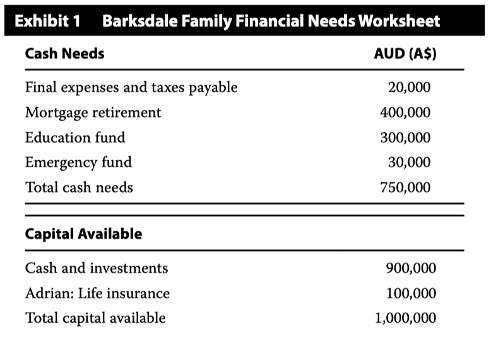Adrian and Olivia Barksdale live in Australia with their 16-year-old twins. Adrian, 47, works in a highly cyclical industry as an engineering manager at a bauxite mine. Olivia, 46, is an accountant. Barksdales are saving for their retirement and college funding for both children. Adrian’s annual salary is A$190,000; Olivia’s annual salary is A$85,000. e family’s living expenses are currently A$95,000 per year.
Both Adrian and Olivia plan to work 18 more years, and they depend on their combined income and savings to fund their goals. e Barksdales’ new financial adviser, Duncan Smith, recommends an appropriate disability insurance policy to cover Adrian, given his large salary. Because he has a highly specialized job, Adrian is willing to pay for the most comprehensive policy available.
Smith is also concerned about the Barksdales’ existing life insurance coverage. Currently, the Barksdales have a term life policy insuring Adrian with a death benefit of A$100,000. Smith assesses the family’s insurance needs in the event Adrian were to die this year. To do so, Smith uses the needs analysis method based on the financial data presented in Exhibit 1 and the following assumptions:
discount rate is 6.0%, and the tax rate is 30%.
Salary and living expenses grow at 3.5% annually.
Salary and living expenses occur at the beginning of each year.
Following assumptions apply in the event of Adrian’s death:
l Olivia will continue to work until retirement;
l Family living expenses will decline by $30,000 per year;
l Olivia’s projected living expense will be $50,000 per year for 44 years; and
l children’s projected living expenses will be $15,000 per year for 6 years.

Next, Smith discusses the advantages and disadvantages of annuities. The Barksdales are interested in purchasing an annuity that offers the following characteristics:
a payout that begins at retirement,
the ability to invest in a menu of investment options, and
a payout that continues as long as either Olivia or Adrian is living.
Olivia’s mother, Sarah Brown, is also a client of Smith. She is age 75 and retired, and she needs a known income stream to assist her with current and future expenses. Brown’s parents both lived longer than average, and she is concerned about outliving her assets. Smith recommends an annuity.
The Barksdales also worry about longevity risk given their family history and healthy lifestyle. Both spouses want an annuity for their later years (beginning in 40 years) that will ensure the greatest supplemental, level income stream relative to the cost. The Barksdales are willing to forgo the right to cash out the policy.
Smith turns to a discussion about the Barksdales’ investment portfolio and how total economic wealth (human capital plus financial capital) might affect asset allocation decisions. The Barksdales’ human capital is valued at $2.9 million and estimated to be 35% equity-like. Smith determines that an overall target allocation of 40% equity is appropriate for the Barksdales’ total assets on the economic balance sheet.
Smith makes two recommendations regarding the Barksdales’ investment portfolio.
Recommendation 1 The portfolio should have lower risk than a portfolio for similar investors in the same lifestyle stage.
Recommendation 2 The portfolio should underweight securities having a high correlation with bauxite demand.
(1)Which type of annuity best satisfies the Barksdales’ desire for supplemental income in their later years?
A Deferred fixed
B Deferred variable
C Advanced life deferred
答案C
为什么这里用C?他的要求是希望之后再付钱——deferred,第二个要求是可以选menu中的投资选择——variable,为什么不选B?
(3)Based on Exhibit 1, and meeting the Barksdales’ target equity allocation for total economic wealth, the financial capital equity allocation should be closest to:
A 35.0%.
B 54.5%.
C 56.1%.
答案C
我计算出出来是B,答案是不是错了?
FC=1m 总资产为FC+HC=3.9 3.9* 40%-2.9*35%=0.545 0.545/1=54.5%.




